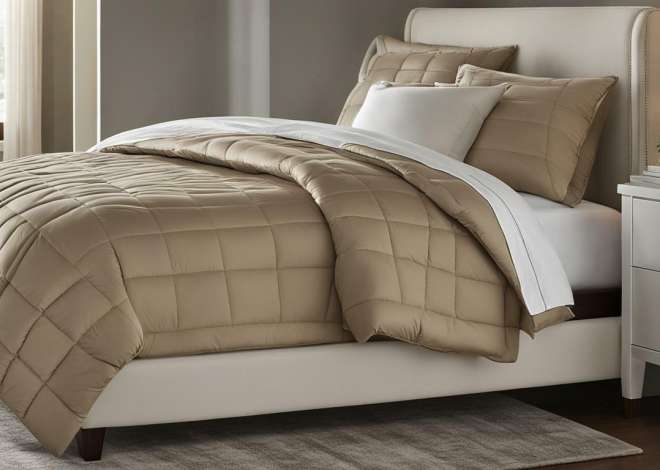
Extra Firm Pillows That Don’t Go Flat
Are you tired of waking up with a sore neck or feeling like your pillow has lost its support? If so, it may be time to consider investing in an extra firm pillow that doesn’t go flat. These pillows are designed to provide optimal support and comfort, ensuring you get a good night’s sleep night after night. In this article, we will explore the importance of pillow firmness, the different materials used in extra firm pillows, the features that make these pillows long-lasting, and how to choose the right firm pillow for your needs. We will also provide tips on maintaining your pillow and knowing when it’s time to replace it.
Understanding the Importance of Pillow Firmness
When it comes to pillows, firmness is a key factor that can greatly impact your sleep quality. The firmness of a pillow refers to its level of support and how it conforms to your head and neck. It is essential to find the right balance of firmness, as it can help alleviate neck and back pain, improve spinal alignment, and enhance overall comfort.
The Role of Pillow Firmness in Sleep Quality
One of the primary roles of pillow firmness is to provide proper support to your head and neck while you sleep. A pillow that is too soft may cause your head to sink too far, leading to misalignment of the spine. On the other hand, a pillow that is too firm may not provide enough give, resulting in discomfort and stiffness. Achieving the ideal firmness level can help promote proper spinal alignment, reduce pressure points, and minimize the risk of waking up with a stiff neck or headaches.
How Pillow Firmness Affects Neck and Spine Health
Poor pillow firmness can have a negative impact on your neck and spine health. If your pillow is too soft, your neck may be placed at an unnatural angle, which can strain the muscles and ligaments. Over time, this can lead to chronic neck pain, headaches, and even cervical spine issues. On the other hand, if your pillow is too firm, it may not allow your neck to properly align with your spine, causing discomfort and potential misalignment. Finding a pillow with the right level of firmness can help support the natural curvature of your spine and promote a healthy sleeping posture.
When selecting a pillow, it is important to consider your personal preferences and sleeping position. Side sleepers often benefit from a firmer pillow to maintain proper alignment between the head, neck, and shoulders. Back sleepers, on the other hand, may find a medium-firm pillow more suitable as it provides adequate support without pushing the head too far forward. Stomach sleepers generally require a softer pillow to prevent strain on the neck and spine.
Additionally, the material of the pillow can also affect its firmness. Memory foam pillows, for example, are known for their ability to contour to the shape of your head and neck, providing customized support. Latex pillows, on the other hand, offer a more resilient and bouncy feel, which can be beneficial for those who prefer a firmer pillow. Feather and down pillows tend to be softer and offer a plush feel, but they may require more fluffing and maintenance to maintain their shape and support.
It is worth noting that pillow firmness is not a one-size-fits-all solution. Each individual has unique preferences and needs when it comes to pillow firmness. Some people may find a medium-firm pillow to be the perfect balance, while others may prefer a softer or firmer option. Experimenting with different firmness levels and pillow materials can help you find the ideal pillow that promotes a restful and comfortable sleep.
Materials Used in Extra Firm Pillows
Extra firm pillows are made using a variety of materials, each with its unique qualities and benefits. Here are two popular materials used in the construction of these pillows:
Memory Foam: A Popular Choice for Firm Pillows
Memory foam is renowned for its ability to contour to the shape of your head and neck, providing personalized support and pressure relief. It is known for its high-density structure, which gives it the firmness needed for optimal support. Memory foam pillows offer excellent durability, as they can maintain their shape and firmness for an extended period.
When you lay your head on a memory foam pillow, it gently molds to the curves of your neck and head, distributing your weight evenly. This helps alleviate pressure points and promotes proper spinal alignment. The result is a comfortable and supportive sleep experience that can help reduce neck and shoulder pain.
Another advantage of memory foam pillows is their hypoallergenic properties. They are resistant to dust mites, mold, and other allergens, making them a suitable choice for individuals with allergies or asthma. The dense structure of memory foam also prevents the accumulation of dust and dirt, ensuring a cleaner sleeping environment.
Latex Pillows: A Natural Alternative
Latex pillows are made from the sap of rubber trees, making them a natural and eco-friendly option. These pillows are often considered medium to firm in terms of firmness, providing ample support while still offering a slight bounce. Latex pillows are highly durable and resistant to mold, dust mites, and other allergens.
One of the unique qualities of latex pillows is their breathability. The open-cell structure of latex allows air to circulate freely, preventing the buildup of heat and moisture. This cooling effect can be particularly beneficial for individuals who tend to sleep hot or experience night sweats.
In addition to their breathability, latex pillows are also known for their responsiveness. When you lay your head on a latex pillow, it instantly adjusts to your movements, providing continuous support throughout the night. This responsiveness helps reduce tossing and turning, allowing for a more restful sleep.
Furthermore, latex pillows are naturally antimicrobial, meaning they inhibit the growth of bacteria, mold, and mildew. This makes them a hygienic choice for those concerned about allergens and maintaining a clean sleeping environment.
Features of Pillows That Don’t Go Flat
When it comes to choosing the perfect pillow, one of the main considerations is finding one that doesn’t go flat over time. Extra firm pillows are designed specifically to maintain their shape and firmness, ensuring long-lasting support and comfort. But what exactly makes these pillows different from the rest? Let’s explore some key features to look for in pillows that don’t go flat.
High-Density Fillings for Long-Lasting Firmness
One of the most important factors that contribute to a pillow’s ability to retain its shape is the type of filling used. Pillows that don’t go flat often utilize high-density fillings such as memory foam, latex, or polyester fibers. These fillings are known for their resilience and ability to bounce back, even after extended use.
Memory foam, for example, is a popular choice due to its unique ability to conform to the shape of your head and neck, providing personalized support. Its high-density nature ensures that it won’t lose its shape easily, allowing you to enjoy consistent firmness and comfort night after night.
Latex, on the other hand, offers a natural alternative with similar benefits. It is derived from the sap of rubber trees and is known for its durability and elasticity. Latex pillows maintain their shape exceptionally well, providing long-lasting support without flattening over time.
For those who prefer a more traditional option, pillows filled with polyester fibers can also be an excellent choice. These fibers are designed to be resilient and retain their loft, ensuring that the pillow remains plump and supportive for an extended period.
Pillow Design and Construction for Durability
While the filling plays a crucial role in preventing a pillow from going flat, the design and construction of the pillow itself also contribute significantly to its longevity.
When searching for a pillow that won’t lose its shape, pay attention to the details of its design. Look for pillows with double stitching, reinforced edges, and durable covers. These features not only enhance the pillow’s overall durability but also prevent the filling from shifting or clumping over time.
Double stitching ensures that the seams are strong and less likely to come undone, keeping the filling securely in place. Reinforced edges provide additional support and prevent the pillow from losing its shape at the corners. A durable cover, preferably made from high-quality materials, adds an extra layer of protection and helps maintain the pillow’s structural integrity.
By investing in a pillow with these design and construction features, you can ensure that it will remain supportive and comfortable throughout its lifespan, without succumbing to the dreaded flatness that plagues lesser pillows.
So, the next time you’re on the hunt for a pillow that won’t go flat, remember to prioritize high-density fillings and look for pillows with sturdy design and construction. With these features in mind, you’ll be well on your way to finding a pillow that provides the perfect balance of support and comfort, night after night.
How to Choose the Right Firm Pillow
Choosing the right firm pillow is crucial for achieving optimal comfort and support while you sleep. A good pillow can make a significant difference in the quality of your sleep and overall well-being. Here are some factors to consider when selecting an extra firm pillow:
Considering Your Sleep Position
Your sleep position plays a significant role in determining the type of firmness you require. Back sleepers usually benefit from medium to firm pillows that provide sufficient support for the neck and upper back. The pillow should help maintain the natural curve of the spine and keep the head aligned with the rest of the body. Side sleepers may prefer a slightly higher loft pillow to maintain proper spinal alignment. This helps to alleviate pressure points and ensures that the neck and shoulders are well-supported throughout the night. On the other hand, stomach sleepers often need softer pillows to avoid undue strain on the neck. A pillow with less loft and a softer feel can help prevent the neck from being forced into an unnatural position.
Assessing Pillow Size and Thickness
Pillow size and thickness are essential considerations as well. Standard-sized pillows are suitable for most people, providing adequate support and comfort. However, if you have broader shoulders or prefer a larger sleep surface, a queen or king-sized pillow may be more suitable. These larger pillows can help distribute weight more evenly and provide better support for the entire upper body. Additionally, the thickness of the pillow should allow for proper alignment of your spine. Consider your body frame and personal preference when choosing the thickness of your firm pillow. A pillow that is too thick can cause the head to be pushed forward, straining the neck and shoulders. On the other hand, a pillow that is too thin may not provide enough support, leading to discomfort and restless sleep.
When selecting a firm pillow, it’s important to take into account your individual needs and preferences. Some people may find that a slightly softer firmness level works best for them, while others may prefer a pillow with a higher firmness rating. It’s also worth considering the materials used in the pillow. Memory foam pillows, for example, can offer excellent support and contour to the shape of your head and neck. Latex pillows are known for their durability and resilience, while down pillows provide a luxurious and plush feel.
Ultimately, the right firm pillow will depend on your unique sleep needs and preferences. Take the time to try out different options and consider factors such as sleep position, pillow size, thickness, and material. By choosing the right firm pillow, you can ensure that you wake up feeling refreshed and well-rested, ready to take on the day ahead.
Maintaining Your Extra Firm Pillow
To ensure the longevity and performance of your extra firm pillow, it is important to provide proper care and maintenance. Here are some tips to keep your firm pillow in excellent condition:
Cleaning and Care Tips for Firm Pillows
Follow the manufacturer’s instructions for cleaning your firm pillow. Many memory foam and latex pillows cannot be machine washed and require spot cleaning. For pillows with removable covers, wash them regularly according to the care label instructions. Using a pillow protector can help prevent stains and dirt from seeping into the pillow, prolonging its lifespan.
When to Replace Your Pillow
Even the highest quality pillows will eventually lose their firmness and support over time. If you notice that your pillow is no longer providing the necessary support or if it has become lumpy or misshapen, it’s time to consider replacing it. On average, pillows should be replaced every 1 to 2 years, depending on their quality and usage. Investing in a new firm pillow will ensure that you continue to enjoy the benefits of optimal support and comfort.
By selecting an extra firm pillow that doesn’t go flat, you can significantly improve your sleep quality and overall well-being. The right firmness level, coupled with high-quality materials and proper maintenance, can provide the support your body needs for restful nights and pain-free mornings. So, invest in a firm pillow today and experience the difference it can make in your sleep!
Frequently Asked Questions
-
Can firm pillows help with neck pain?
Firm pillows can provide excellent support for your neck, helping to alleviate neck pain and stiffness. However, it’s important to find the right level of firmness that works for you, as pillows that are too firm or too soft may exacerbate the pain. Consider consulting a healthcare professional for personalized advice.
-
Are extra firm pillows suitable for all sleep positions?
While extra firm pillows can work well for back and side sleepers, they may not be the best choice for stomach sleepers. Stomach sleepers typically need softer pillows to avoid strain on the neck. Consider your sleep position when choosing the firmness level of your pillow.
-
Are latex pillows better than memory foam pillows?
The choice between latex and memory foam pillows ultimately comes down to personal preference. Latex pillows are natural and hypoallergenic, while memory foam pillows offer personalized support and pressure relief. Consider your specific needs and preferences to determine which material is the best fit for you.
-
Can I adjust the firmness of my pillow?
Some pillows offer adjustable firmness options, allowing you to add or remove filling to achieve the desired level of firmness. Check the product description or label to see if the pillow is adjustable. Keep in mind that not all pillows offer this feature.
-
What are the signs that my pillow needs to be replaced?
If your pillow has lost its shape, flattened out, or is causing discomfort, it may be time to replace it. Other signs include visible wear and tear, an unpleasant odor, or allergies worsening despite regular cleaning. Investing in a new pillow will help ensure that you continue to enjoy the benefits of optimal support and comfort.
-
How often should I clean my extra firm pillow?
Follow the manufacturer’s instructions for cleaning your extra firm pillow. In general, it is recommended to clean pillowcases and covers regularly, while pillows themselves may require spot cleaning or professional cleaning. Protecting your pillow with a removable pillowcase or pillow protector can help prolong its cleanliness.
-
Can I use an extra firm pillow while traveling?
Yes, you can use an extra firm pillow while traveling if you prefer a firmer surface for support. Look for travel-sized or compact versions of extra firm pillows, or use a compression bag to reduce the size of your pillow for easy packing.


